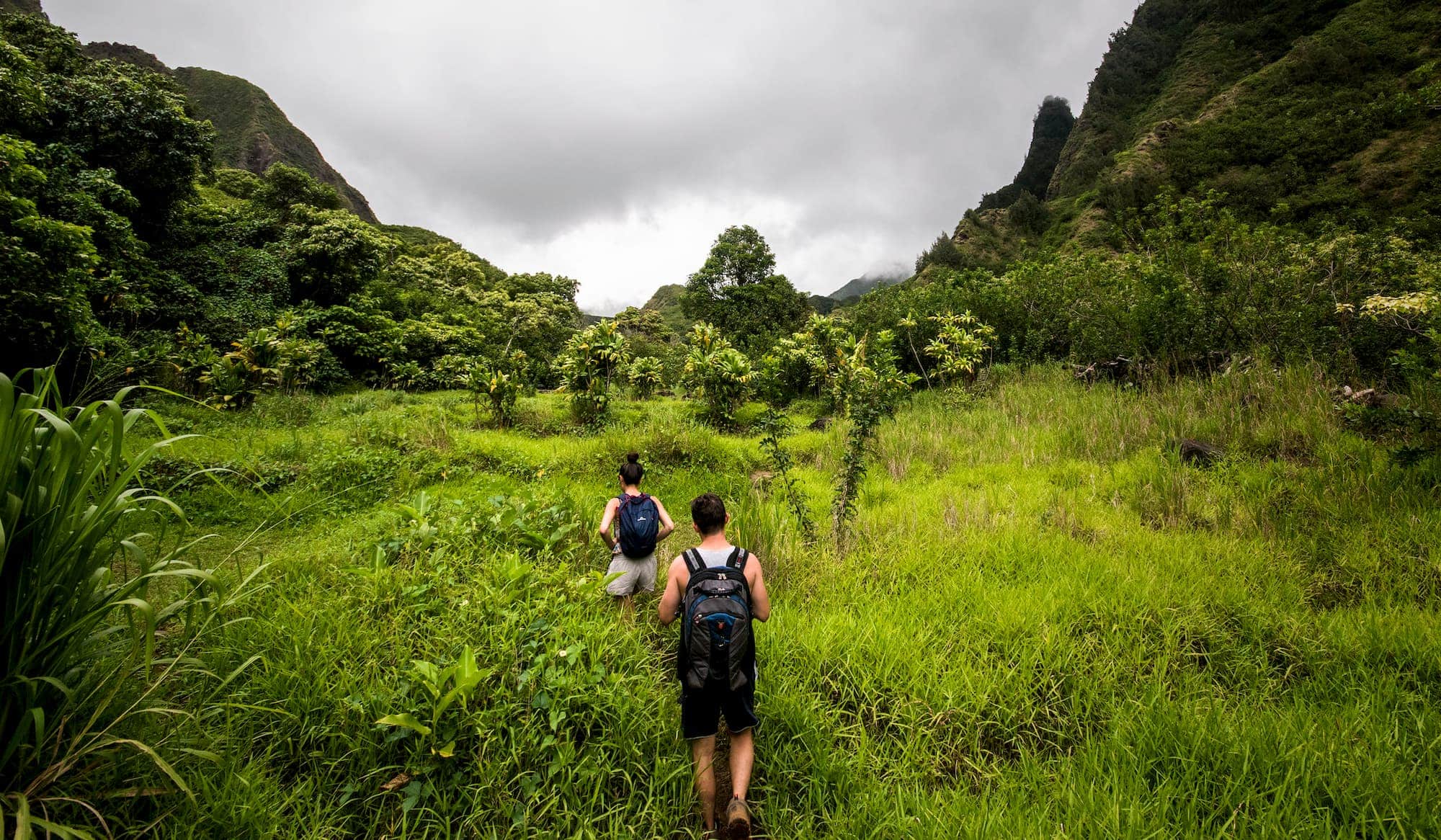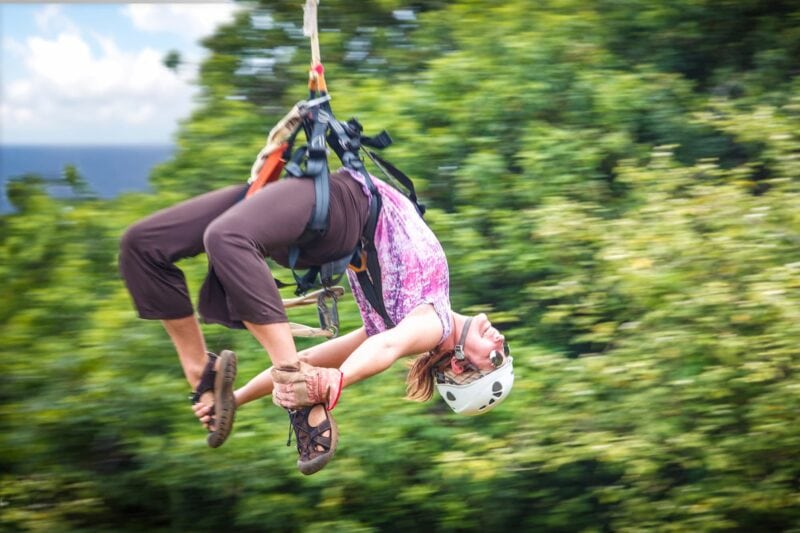While Maui’s waters draw much of the attention with world-class snorkeling, whale watching, and boating, the island’s land-based adventures are just as spectacular—if not more diverse.
Maui’s collection of beaches are considered some of the best in the world, and the island has spectacular scenic drives, dense jungles, and tall volcanic peaks to explore. Most notably, the hiking trails of Haleakalā rise to more than 10,000 feet above sea level.
Ocean-view golf, cultural luaus, waterfall chasing, and horseback riding can be found on every Hawaiian Island, but Maui’s landscape makes each one of them unique. It is via these outdoor and culturally-based activities that we are able to see and experience Maui through a different lens.
Table of contents
Table of Contents
- ATV Tours
- Beaches
- Golf
- Farm Tours
- Hiking
- Horseback Riding
- Luau shows
- Parks and Botanical Gardens
- Scenic Drives
- Star Gazing
- Volunteering Opportunities
- Waterfalls
- Ziplining
Ready to explore Maui on foot, by ATV, or on horseback? Here’s a roundup of the best land-based activities to experience the island’s breathtaking scenery, culture, and adventure.
Land activities on Oʻahu and Kauaʻi
We have made similar overviews of the land activities on Oʻahu and Maui in which we list the respective highlights for the islands and give a few recommendations for tour operators. Make sure to check these out if your trip takes you to one of those islands:
If you are more interested in getting your feet wet you should check out our list of Maui water activities.
ATV and Off-Road Tours
Maui’s rugged terrain makes ATV tours an adrenaline-pumping way to explore the island. Ride through the dramatic landscapes of the West Maui Mountains, one of the two volcanoes that shaped the island. These guided off-road adventures typically last two hours or less, with multiple scenic stops along the way.
You can compare all ATV tours on Maui in our dedicated guide.
Tip: Bring a change of clothes and a towel. ATV tours go out rain or shine and that’s a good thing – a big part of the fun can be racing through the mud and crossing seasonal streams.
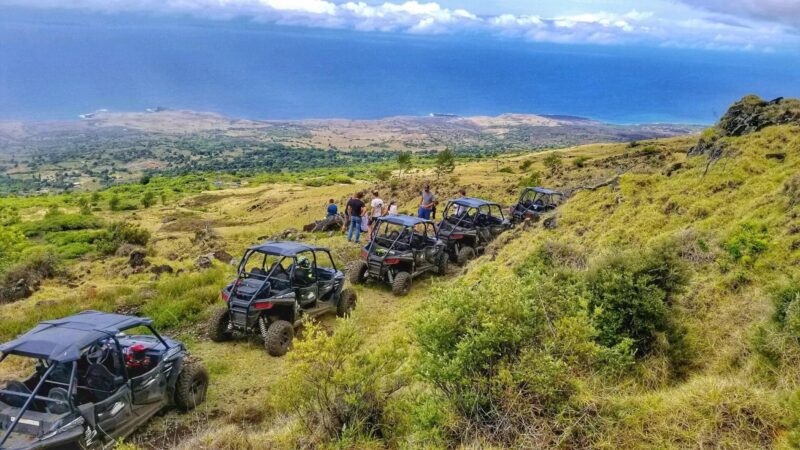
The Maui Off-road Adventure ATV tour brings you by viewpoints that offer sweeping ocean and outer island views. Credit: the Maui Offroad Adventures Facebook page.
Beaches
Maui’s beaches are postcard-perfect, with everything from powdery white sand to dramatic black and red shores. Unlike Oʻahu, Maui’s coastline offers more secluded getaways, where you can relax without the crowds. Plus, from December to April, you might even spot humpback whales breaching right offshore—no boat required!”
Maui doesn’t have the big-name beach recognition like Waikīkī or the North Shore on Oʻahu, but don’t be fooled. Maui has a beach for everyone, and they are generally less crowded than those on Oʻahu. You can read more in our guide to beaches on Maui.
Here is a preview our recommendations:
- Best beaches to take kids: Kaʻanapali (pictured below)
- Best beach for beginner surfing: Puamana and Launiupoko.
- Best beach to go snorkeling: There are many great snorkeling beaches in and around Wailea.
- Best beach to get away from the crowds: The lesser known beaches in west and south Maui.
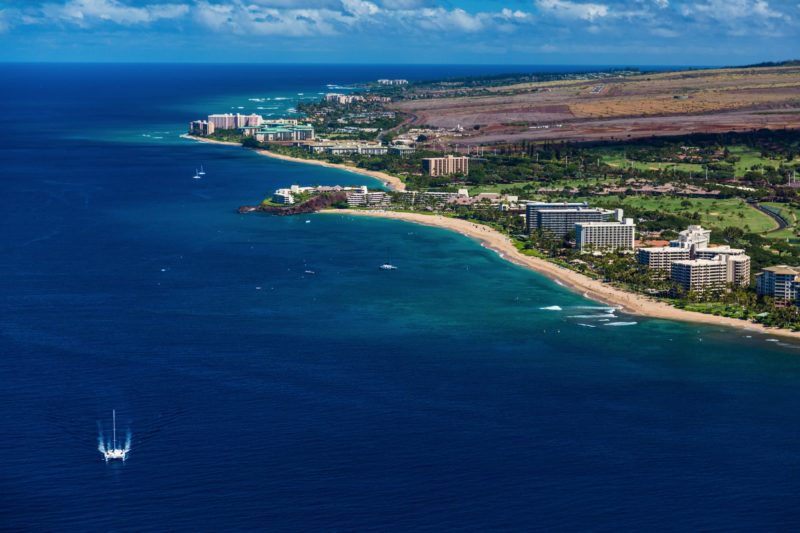
Kaʻanapali beach is a popular hangout and famous for cliff diving, snorkeling, and scenic walks along the 3-mile shoreline. Credit: Hawaii Tourism Authority (HTA) / Tor Johnson
Golf
Tee off with a view! Maui’s golf courses aren’t just about the game—they’re about the scenery. Imagine lining up your shot with waves crashing in the distance or towering volcanic peaks behind you. Whether you’re a pro or just in it for the stunning backdrops, Maui’s courses deliver.
Golfers will be pleased to know that Maui has 14 courses to choose from, many offering ocean and/or mountain views, the fairways well-groomed below palm trees and adjacent to lava flows.
The courses in Kapalua and Kaʻanapali are known for their ocean views in resort settings, as are the Blue Course and Emerald Course in Wailea, which have won awards for their design and play. These courses are about as good as it gets, but it will cost you somewhere in the $200-$300 range to play them (or more).
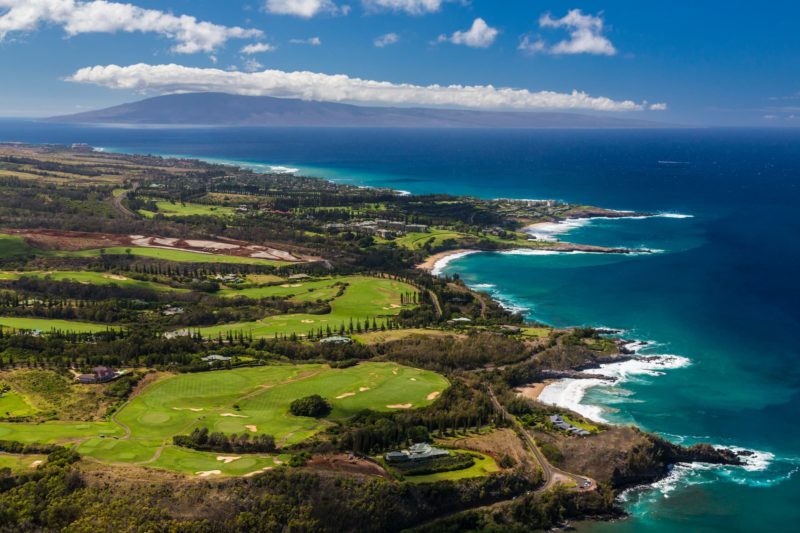
Kapalua golf course with Lanai in the background. Image credit: Hawaii Tourism Authority (HTA) / Tor Johnson
There are a handful of local, public courses sprinkled elsewhere around the island, such Kalihi Golf Course, the Dunes at Maui Lani, and Waiehu Municipal Golf Course, among others. Rates at these public courses not associated with resorts are much more affordable, with greens fees often less than $100.
Farm Tours
Want a taste of Maui beyond the beaches? Head upcountry, where the slopes of Haleakalā are dotted with farms growing everything from coffee and lavender to dragon fruit and pineapples. Many offer interactive tours where you can pick fresh fruit, sip locally-made wine, or even meet the famous ‘surfing goats’ of Surfing Goat Dairy.”
Given that Hawaiʻi is one of the most isolated island chains in the world, how it manages its food production and supply is often an interest of visitors. Since it became part of the United States, Hawaiʻi has imported close to 100% of its food. But in recent years, farmers have been trying to reestablish a locally-sourced food chain. Below are some tours we recommend if you’re interested in learning more about Maui’s agriculture and local food production, both past and present:
- Oʻo Farms: Located at 3,500 feet above sea level, Oʻo Farms supplies local restaurants with its local produce. For those interested in learning more about the local food production, the lunch tour at Oʻo will literally give you a taste of what the island has to offer.
- Haliʻimaile Pineapple Tour: There’s a lot going on at Haliʻimaile Plantation, including a local distillery and tasting room. But the big draw here is still the pineapples, which have become nearly synonymous with Hawaiʻi. A (tour of the growing fields) will explain the industry’s deep connection to the islands and how it plans to move forward in the future.
- MauiGrown Coffee: It’s no secret that Hawaiʻi grows good coffee, and though the Big Island’s Kona District is most famous, every island produces its own coffee. A farm tour at MauiGrown Coffee provides a chance to sample different varieties and buy some as a souvenir or gift to take home.
- Aliʻi Kula Lavender Farm: See teh softer side of Maui at the Alii Kula Lavender Farm. Tours and family friendly activities explain how to best use lavender. Buy some to take home, and learn how to use it in recipes.
- Maui Dragon Fruit Farm: Come see this bright, colorful, exotic fruit’s unique growing process, and taste other locally-grown fruit on this hour-long, family-friendly tour.
- Surfing Goat Dairy: Love goat cheese and other dairy products? Meet the “surfing goats” and take part in the milking process before sampling locally-made cheese.
Do you like good and local food? Check out our guide to culinary tours and activities on Maui.
Hiking
From lava-rock landscapes to lush rainforests, Maui’s hiking trails showcase the island’s stunning diversity. Whether you’re trekking through bamboo forests to hidden waterfalls or climbing above the clouds at Haleakalā’s summit, there’s a trail for every level of adventurer.
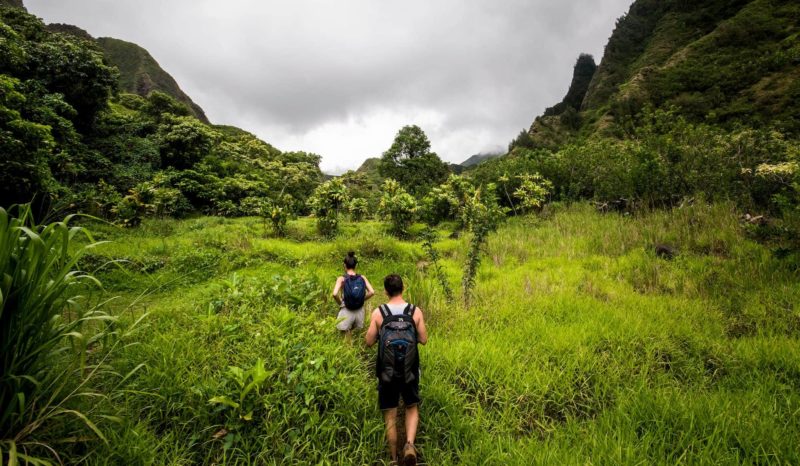
The Iao Valley Trail takes you through a beautiful narrow and lush valley. Image credit: Xavier Lafarge, source.
Hiking all the island has to offer will take several visits, but here are some hikes we recommend to get you started:
- Easy: The ʻIao Valley State Monument has a paved walking trail (.6 miles) that presents a view of the ʻIao Needle, a famous ridge formation in the uber-lush Iao Valley. It’s a great area for those who want to go into nature without getting their shoes dirty.
- Intermediate: The Pīpīwai Trail (4 miles roundtrip) is located on the backside of Haleakalā in the Kīpahulu District of Haleakalā National Park. It takes you through a jungle rainforest into a bamboo forest, ending at a 400-foot Waimoku Falls.
- Hard: The Sliding Sands Trail runs on for 11 miles through the Haleakalā Volcano summit area. It’s a wonderful introduction to the ecosystem of a volcanic crater, with cinder cones and red rock. It is completely exposed to the elements, including the harsh sun, strong wind, and cold air (temperatures can be near freezing at the summit), so be sure to bring sun protection, plenty of water, and snacks.
See our list of our 15 favorite hikes on Maui, where we break them down into groups of 5 easy, 5 intermediate, and 5 advanced hikes.
🔥 Pro Tip: If you’re hiking Haleakalā, go early—sunrise is legendary, but reservations fill up fast!
Horseback Riding
Saddle up for an unforgettable ride through Maui’s scenic landscapes! Whether you’re trotting along windswept coastal cliffs, meandering through rolling pastures, or climbing into misty mountain valleys, a horseback tour is a relaxing way to soak in the island’s beauty. Many rides include stops at hidden lookouts or even cattle ranches, where you can get a taste of Maui’s paniolo (cowboy) culture.
Horseback riding tours are also a great way to learn more about ranching in modern-day Hawaiʻi. When combined with ocean or mountain scenery, the rides are a fun, family-friendly outdoor option that allow you to explore the land and see how ranching still plays a major role in Hawaiʻi’s economy and lifestyle. For this reason, we recommend choosing an outfitter that is associated with an actual ranch. This ensures the horses are well cared for, and allows you to learn about the historical and cultural component directly from the source.
You can read more in our guide to horseback riding tours on Maui. Some horseback tours we recommend in that guide are:
- West Maui: Ironwood Ranch is located high in the West Maui Mountains above Napili, between Kaʻanapali and Kapalua. The rides take you through the highlands, including tropical valleys, pineapple fields, and ironwood forests. The routes on the mountainside offer views overlooking the island and ocean. Sunset tours are also available.
- South Maui: Triple L Ranch is a history-soaked outfitter that puts the Paniolo pastime front and center. Located in a remote corner of South Maui, the rides at Triple L explore the privately-owned ranch property, with sweeping views of the coast and ocean.
- Upcountry Maui: Thompson Ranch is located high on the slopes of Haleakalā between 4,000 and 6,500 feet, and the rides take place right there on property. If you’re looking for a horseback riding experience that will give you an inside look into local ranch life, Thompson Ranch is the outfitter for you.
- North Shore: Circle M Ranch is located on the western part of the north shore outside of Wailuku. Its rides explore its ranch but also take you down to the coast, where you can overlook the rocky coastline of northern Maui.
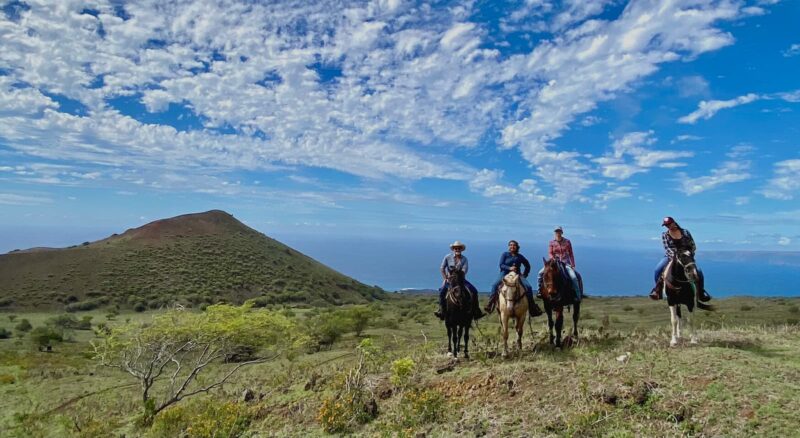
The rides by Triple L Ranch take you down the dormant volcanoes slopes of Haleakalā. Image: Triple L Ranch.
Lūʻau shows
If you’re looking for evening entertainment that celebrates Hawaiian and Polynesian culture, then a lūʻau is right up your alley.
Full of storytelling and dance, the performances take place around sunset and bring you on a journey back in time to retrace the ancestral history of the islands. The live shows are typically accompanied by a pig roast and all-you-can-eat buffet, and some include an open bar. Audience participation is part of the show as well.
Don’t miss: Our complete overview of Maui Luau shows. See also our guides to all Lūʻau shows on the Big Island, to the 6 Kauaʻi luau shows, and to the 10 Lūʻau shows on Oʻahu, to read our recommendations for the other islands.
Lūʻaus in Hawaiʻi vary in their authenticity and food quality, but overall, they offer a family-friendly environment and provide a chance to try Hawaiian foods and digest its cultural history. There are many to choose from on Maui, but here are a few we recommend:
- Best Lūʻau for families: The Myths of Maui Lūʻau at the Royal Lāhainā Resort in Kaʻanapali offers an incredible view of the sunset and a fire dancing performance that kids are sure to enjoy.
- Best Lūʻau for foodies: The Feast at Lele Luau in Lāhainā has the most comprehensive menu of all luaus, offering five courses from four different Polynesian nations: Hawaiʻi, Aotearoa (New Zealand), Tahiti, and Samoa.
- Most Authentic Lūʻau: The Old Lāhainā Lūʻau has consistently been regarded as the most authentic on Maui for its attention to detail and quality of its music and dancing.
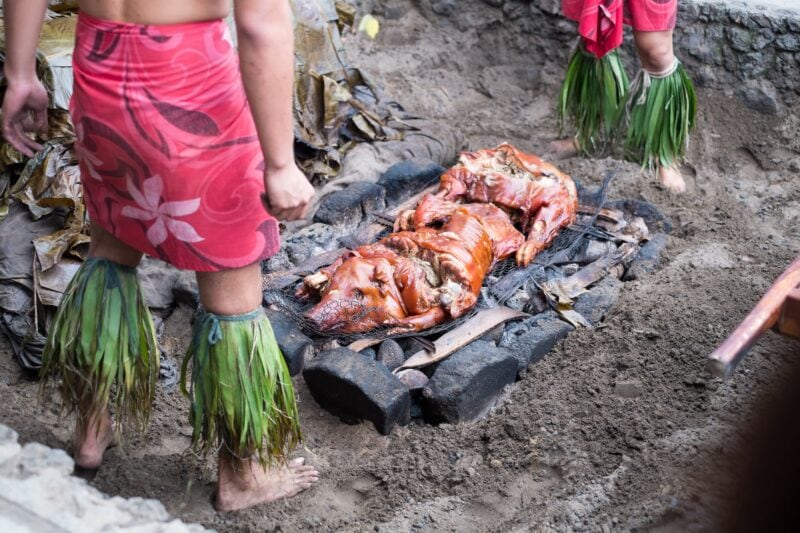
Imu ceremony at the Grand Wailea Luau. Image credit: Daisy Images, source.
State Parks & Botanical Gardens
State Parks
There are 8 state-run recreation areas (parks, monuments, waysides, etc.) on Maui that showcase and preserve the island’s natural beauty.
Some, like the infamous ʻĪao Valley State Monument – home of the ʻĪao Needle in the West Maui Mountains – are well known and get lots of visitation. Others remain overlooked and under-visited.
You can view a full list of state-run parks in Maui here, but here are a few we recommend (besides ʻĪao Valley).
- Adventure Hiking: The forests and trails of Polipoli Spring State Recreation Area in the high elevations of Haleakalā are a lesser-known treat, often immersed in clouds. Adventurers looking to get off the beaten path on Maui should check out this area, which also has a cabin and campground.
- Beach and Swimming: Mākena State Park, located in southwest Maui, is a beautiful, sprawling white-sand beach located amongst old cinder cones.
- Fishing, Beach Camping, and Black Sand: Wai’ānapanapa State Park in Hana will take some time to reach, but it’s a favorite amongst locals for fishing and camping. Visitors will love its rocky coastline and black-sand beach.
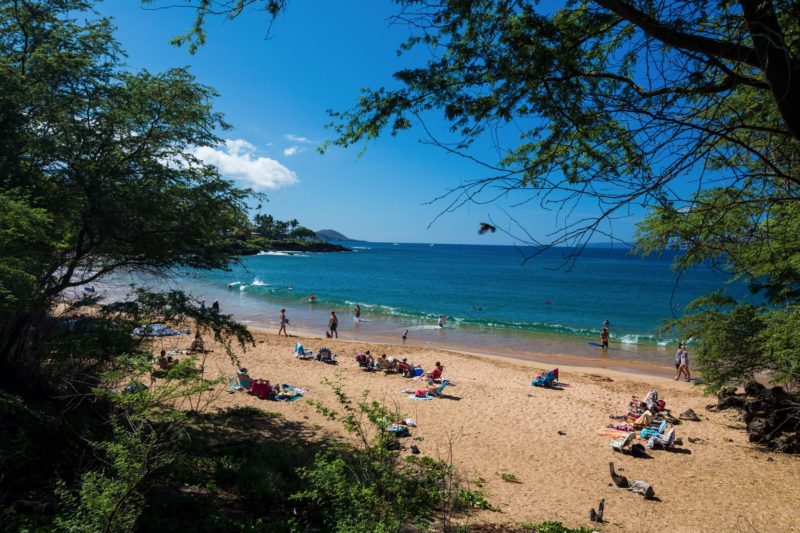
Makena is a spacious and scenic beach ideal for swimming & snorkeling. Credit: Hawaii Tourism Authority (HTA) / Tor Johnson
Botanical Gardens
Botanical gardens often get overlooked in Hawaiʻi, probably because there’s so much beautiful scenery to be enjoyed all around, wherever you are on island. But flora lovers should make time to dig a little deeper. Botanical gardens in Maui offer a look at local Hawaiian plants that make up the changing, unique landscape.
- The Maui Nui Botanical Gardens offers guided tours of its seven-acre complex, which features both Hawaiian and Polynesian varietals. The tours provide a look into the natural history of Maui, including its conservation and cultural efforts.
- The Kula Botanical Gardens is located 3,300 feet above sea level on the slopes of Haleakalā. Started in 1968, it is 8 acres in size and features waterfalls, koi ponds, and high ocean views. There’s also orchid, fuchsia and bromeliad houses to go along with a bird sanctuary for the endangered Nene bird (Hawaiʻi’s state bird).
Scenic Drives
Maui is made for road trips! While the legendary Road to Hāna steals the spotlight, the island offers plenty of other scenic drives that showcase its jaw-dropping beauty. From coastal highways hugging turquoise waters to winding roads through upcountry ranchlands, every turn reveals a new breathtaking view.
There are four areas/loops in particular that are great to explore in road-trip fashion. Check out our 4 favorite Maui road trips for more details. As a spoiler here are highlights of 2 of our favorites:
- Road to Hana: The most scenic and dramatic drive in all of Hawaiʻi, the Road to Hana is a drive most people make when they come to Maui, exploring overlooks, waterfalls, and dense jungle along the way. See our guide to the Road to Hana for the full details.
- Northwest Maui Loop: Most people are familiar with the west side of Maui surrounding Lāhainā and Kaʻanapali. But the northwest side of Maui between Kapalua and Wailuku remains lesser explored, mostly because it doesn’t have a hub or town. The road in this part of the island hugs the coast and offers many chances to pull over for ocean views and its rolling, grassy volcanic hillsides.
Tip: You’ll want to take traffic into consideration when planning a scenic drive (i.e. don’t head out at rush hour).
Star Gazing
Though not as popular as stargazing on the Big Island, Maui does offer visitors a unique window into the night sky from the slopes of Haleakalā – or the beach! As one of the most isolated island chains in the world, the conditions are perfect for viewing the night sky, and a tour can help bring it to life.
You can drive to the summit to see for yourself (check out our other favorite stargazing spots on Maui), but jumping on a tour is also convenient. Most tours begin before sunset and offer narration of both the National Park and the night sky, including the use of telescopes. Check out the tours from Maui Stargazing, Maui Astronomy Tours, or Hawai‘i Tours.
If you are more of a beach-loving stargazer do have a look at the tour offered by Stargaze West Maui. They take their guests on a 1- hour guided stargazing tour during which they use a powerful Schmidt-Cassegrain to show planets, stars, star clusters, nebulae, and galaxies, while sharing Hawaiian history and mythology connected to the night sky.
Volunteering opportunities
Volunteering while on vacation? Sounds strange at first, but if you’re looking to connect with the local community, there’s no better way than taking a half day to help a local organization with a project. In many cases, the volunteer experience offers exclusive access to a site, as well as the chance to meet and mingle with residents. You can find many opportunities for volunteering on the GoHawaii website, or the Hands on Maui Volunteer Center.
The Sanctuary Ocean Count
During whale season, there’s a special opportunity to go whale watching and help scientists count whales.
The Sanctuary Ocean Count is organized during peak whale season (November-April) and helps scientists get a snapshot of humpback whale sightings off the coast of Maui (and the other islands as well). You must register to participate, and then you can help document sightings and behavior. The days change each year, so be sure to check the link above for the latest updates.
Waterfalls
Maui’s north shore and east coast are loaded with waterfalls. In fact, they are the main draw of the Road to Hana, pouring out of the jungles and down the cliffs into the ocean.
The waterfalls differ in size, ease of access, and swimmability. Below are some recommendations of waterfalls to visit:
- Best for ease of access/swimming: Twin Falls. It’s easy to access from the road via hike of just a little more than a mile, and there’s a large pool for swimming at the bottom of the falls.
- Biggest: Honokohau Falls drops about 1,100 feet, but unfortunately it is not accessible via foot. To see it, you must take a helicopter tour.
- Best for Families: The Seven Scared Pools, also known as Pools of Oheʻo, are located on the backside of Haleakalā in the Kīpahulu District. They are easily viewed from the cliffs above. You can also hike the nearby Pīpīwai Trail through a bamboo forest to end up at the 400-foot Waimoku Falls. For families, it’s easy to spend a half day or more exploring this area.
For more waterfall goodness see our list of 10 Maui waterfalls.
If you are like us and can’t get enough of waterfalls, check out our lists of waterfalls on Oʻahu, Kauaʻi Waterfalls, and waterfalls on the Big Island.
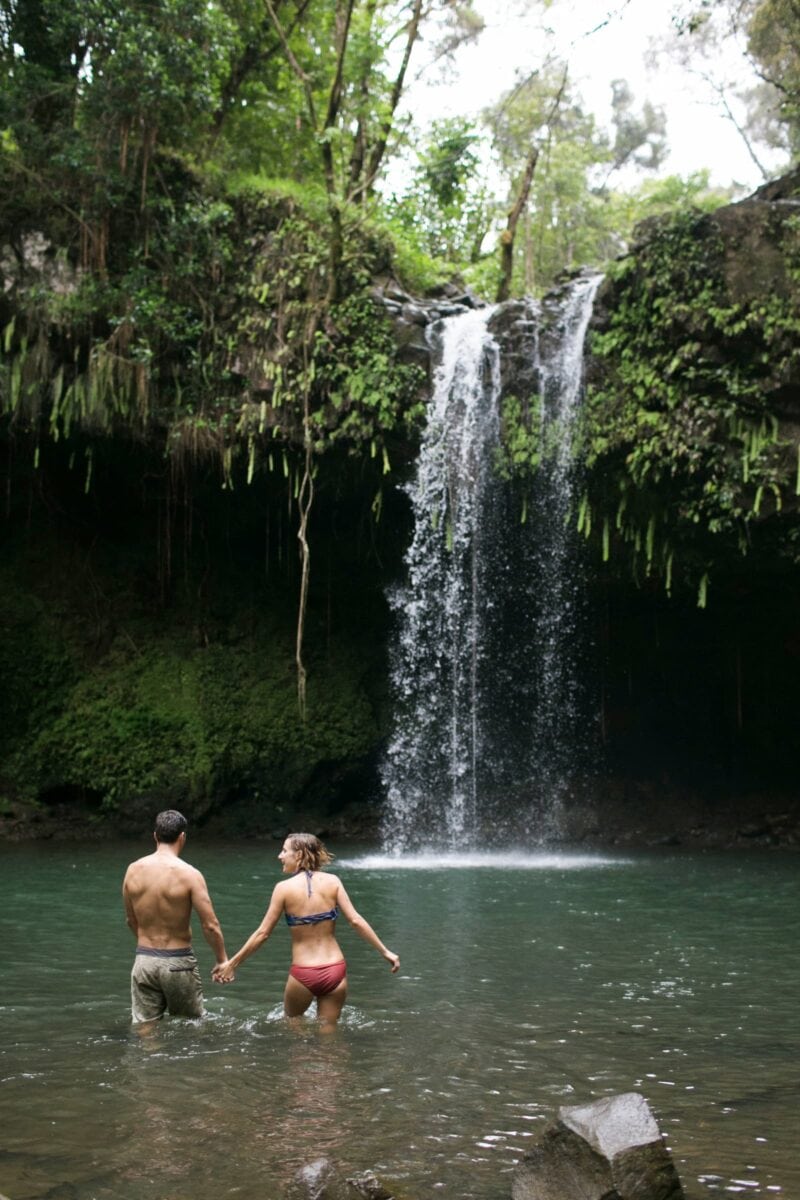
Located between mile marker 2 and 3, Twin Falls is the first easily accessible string of waterfalls and pools on the Road to Hana. Credit: Hawaii Tourism Authority (HTA)
Ziplining
Ziplining is a popular activity for all-age groups, combining adventure, adrenaline, and scenic beauty. Maui has five zipline courses spread around the island, each one offering something different in terms of its size, scenery, stature, and extra activities. For example, north shore ziplines offers the best value, Jungle Ziplines is the most affordable, and the Kapalua zipline (see below) is great for families.
6 Zipline Tour on the west Maui mountain slopes
Race your friends and family on dual ziplines across the best Pacific scenery on Maui! Includes ATV Rainforest ride and suspension bridge crossing.
from:
$220
What is a suggested tour?Our suggested tours are hand-picked tours that receive consistent good reviews, give back to the community, and work hard to minimize their impact on the environment. Read more about these tours on our website.Read all our recommendations in our guide to ziplining on Maui.
